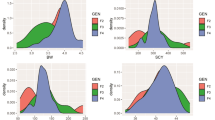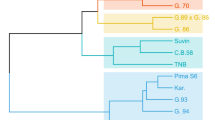Abstract
In a hypothetic population of cotton, Gossypium hirsutum L., segregating for 26 independent alleles, individuals with all desired alleles are more abundant in early generations (F2 or F3), but a high proportion of allelic loci are homozygous in late generations (F4 or F5). This dichotomy needs to be considered to establish a successful breeding strategy. In this study, we examined the effectiveness of two pedigree procedures in cotton with their key difference in the self-generations used for single plant selection. The conventional procedure started single plant selection at F3 by hand-harvest of a 30-boll sample from individual plants, then in the follow-up generation, only those derived lines retained after culling for lint percent and High Volume Instrument (HVI) fibre quality entered the progeny row test. The alternative procedure used single-locule descent for pass-through of early generations; at F5, only two mature bolls were harvested from selected individual plants, and their derived lines were grown and culled in single-row plot nursery by visual assessment, and by lint percent and HVI fibre properties measured from a 30-boll sample. When each procedure was used to develop elite inbred lines in two populations derived from outstanding cotton lines, both procedures were effective at identifying elite lines from the populations. The alternative procedure captured more elites than the conventional one, based on the retention rate against the initial population size, particularly in one population, and required less resources in the process. Thus, the alternative procedure with delayed single plant selection is effective and efficient for cotton improvement.



Similar content being viewed by others
References
Allard RW (1960) Principles of plant breeding. Wiley, New York
Bernardo R (2002) Breeding for quantitative traits in plants. Stemma, Woodbury
Bernardo R (2016) Bandwagons I, too, have known. Theor Appl Genet 129:2323–2332
Bernardo R, Yu J (2007) Prospects for genomewide selection for quantitative traits in maize. Crop Sci 47:1082–1090. https://doi.org/10.2135/cropsci2006.11.0690
Boerma HR, Cooper RL (1975) Comparison of three selection procedures for yield in soybeans. Crop Sci 15:225–229. https://doi.org/10.2135/cropsci1975.0011183X001500020025x
Bowman DT (2000) Attributes of public and private cotton breeding programs. J Cotton Sci 4:130–136
Bowman DT, Bourland FM, Myers GO, Wallace TP, Caldwell D (2004) Visual selection for yield in cotton breeding programs. J Cotton Sci 8:62–68
Butler DG, Cullis BR, Gilmour AR, Gogel BJ (2009) ASReml-R reference manual. Queensland Department of Primary Industries & Fisheries, NSW Department of Primary Industries, Training Series QE02001, 3rd Version. The State of Queensland, Department of Primary Industries & Fisheries
Calhoun DS, Bowman DT (1999) Techniques for development of new cultivars. In: Smith CW, Cothren JT (eds) Cotton: origin, history, technology, and production. Wiley, New York, pp 361–414
Campbell BT, Weaver DB, Sharpe R, Wu J, Jone DC (2013) Breeding potential of elite Pee Dee germplasm in upland cotton breeding programs. Crop Sci 53:894–905
Clement JD, Constable GA, Stiller WN, Liu SM (2012) Negative associations still exist between yield and fibre quality in cotton breeding programs in Australia and USA. Field Crops Res 128:1–7. https://doi.org/10.1016/j.fcr.2011.12.002
Clement JD, Constable GA, Stiller WN, Liu SM (2015) Early generation selection strategies for breeding better combinations of cotton yield and fibre quality. Field Crops Res 172:145–152. https://doi.org/10.1016/j.fcr.2014.11.009
Constable GA, Thomson NJ, Reid PE (2001) Approaches utilized in breeding and development of cotton cultivars in Australia. In: Jenkins JN, Saha S (eds) Genetic improvement of cotton: emerging technologies. Science Publishers, Enfield, pp 1–15
Culp TW, Harrell DC, Kerr T (1979) Some genetic implications in the transfer of high fiber strength genes to upland cotton. Crop Sci 19:481–484
Jones DG, Smith CW (2005) Early generation testing in upland cotton. Crop Sci 46:1–5. https://doi.org/10.2135/cropsci2004.0517
Keim P, Beavis WD, Schupp JM, Baltazar BM, Mansur L, Freestone RE, Vahedian M, Webb DM (1994) RFLP analysis of soybean breeding populations. 1. genetic-structure differences due to inbreeding methods. Crop Sci 34:55–61
Kempton RA, Gleeson AC (1997) Unreplicated trials. In: Kempton RA, Fox PN, Cerezo M (eds) Statistical methods for plant variety evaluation. Springer, Dordrecht, pp 86–100. https://doi.org/10.1007/978-94-009-1503-9_6
Kervella J, Fouilloux G (1992) A theoretical study of the bulk breeding method. 1. importance and consequences of losses due to sampling. Euphytica 60:185–195
Knott DR, Kumar J (1975) Comparison of early generation yield testing and a single seed descent procedure in wheat breeding. Crop Sci 15:295–299
Lacape J-M, Llewellyn D, Jacobs J, Arioli T, Becker D, Calhoun S, Al-Ghazi Y, Liu S, Palai O, Georges S, Giband M, de Assuncao H, Barroso P, Claverie M, Gawryziak G, Jean J, Vialle M, Viot C (2010) Meta-analysis of cotton fiber quality QTLs across diverse environments in a Gossypium hirsutum × G. barbadense RIL population. BMC Plant Biol 10:132
Liu SM, Constable GA, Reid PE, Stiller WN, Cullis BR (2013) The interaction between breeding and crop management in improved cotton yield. Field Crops Res 148:49–60. https://doi.org/10.1016/j.fcr.2013.04.006
Liu SM, Constable GA, Cullis BR, Stiller WN, Reid PE (2015) Benefit of spatial analysis for furrow irrigated cotton breeding trials. Euphytica 201:253–264. https://doi.org/10.1007/s10681-014-1205-2
Llewellyn D, Tyson C, Constable GA, Duggan B, Beale S, Steel P (2007) Containment of regulated genetically modified cotton in the field. Agric Ecosyst Environ 121:419–429
Meredith WR Jr (1984) Quantitative genetics. In: Kohel RJ, Lewis CF (eds) Cotton. ASA, CSSA, pp 131–150
Meredith WR Jr, Bridge RR (1971) Breakup of linkage blocks in cotton, Gossypium hirsutum L. Crop Sci 11:695–698
Meredith WR Jr, Bridge RR (1973) The relationship between F2 and selected F3 progenies in cotton (Gossypium hirsutum L.). Crop Sci 13:354–356
Muehlbauer FJ, Burnell DG, Bogyo TP, Boygo MT (1981) Simulated comparisons of single seed descent and bulk population breeding methods. Crop Sci 21:572–577
Padi FK, Ehlers JD (2008) Effectiveness of early generation selection in cowpea for grain yield and agronomic characteristics in semiarid west Africa. Crop Sci 48:533–540
Percy RG (2003) Comparison of bulk F2 performance testing and pedigree selection in thirty Pima cotton populations. J Cotton Sci 7:170–178
Reid PE (2003a) Sicot 71. Plant Var J 16:35–36
Reid PE (2003b) Siokra V-18. Plant Var J 16:36
Said JI, Song MZ, Wang HT, Lin ZX, Zhang XL, Fang DD, Zhang JF (2015) A comparative meta-analysis of QTL between intraspecific Gossypium hirsutum and interspecific G. hirsutum × G. barbadense populations. Mol Genet Genom 290:1003. https://doi.org/10.1007/s00438-014-0963-9
Schwarzbach E (1981) The limits of selection in segregating autogamous populations under ideal and under realistic assumptions. Barley genetics IV Proceedings of the fourth international barley genetics symposium, Edinburgh, 22–29 July 1981:154–158
Simmonds NW (1989) How frequent are superior genotypes in plant breeding populations? Biol Rev 64:341–365
Singh RP, Rajaram S, Miranda A, Huerta-Espino J, Autrique E (1998) Comparison of two crossing and four selection schemes for yield, yield traits, and slow rusting resistance to leaf rust in wheat. Euphytica 100:35–43. https://doi.org/10.1023/a:1018391519757
Smith AB, Cullis BR, Thompson R (2005) The analysis of crop cultivar breeding and evaluation trials: an overview of current mixed model approaches. J Agric Sci Camb 143:449–462
Sneep J (1977) Selection for yield in early generations of self-fertilizing crops. Euphytica 26:27–30
St Martin SK, Geraldi IO (2002) Comparison of three procedures for early generation testing of soybean. Crop Sci 42:705–709
Walsh B, Lynch M (2013) Selection and development of pure lines. Evolution and selection of quantitative traits: Vol II. Department of Ecology and Evolutionary Biology, University of Arizona, Tucson. http://nitro.biosci.arizona.edu/zbook/NewVolume_2/pdf/Chapter30.pdf. Accessed 24 Sept 2017
Wang J, van Ginkel M, Podlich D, Ye G, Trethowan R, Pfeiffer WH, DeLacy IH, Cooper M, Rajaram S (2003) Comparison of two breeding strategies by computer simulation. Crop Sci 43:1764–1773
Wang J, Chapman SC, Bonnett DG, Rebetzke GJ, Crouch J (2007) Application of population genetic theory and simulation models to efficiently pyramid multiple genes via marker-assisted selection. Crop Sci 47:582–588. https://doi.org/10.2135/cropsci2006.05.0341
Wang J, Singh RP, Braun HJ, Pfeiffer WH (2009) Investigating the efficiency of the single backcrossing breeding strategy through computer simulation. Theor Appl Genet 118:683–694
Whan BR, Rathjen AJ, Knight R (1981) The relation between wheat lines derived from the F2, F3, F4 and F5 generations for grain yield and harvest index. Euphytica 30:419–430. https://doi.org/10.1007/bf00034006
Whan BR, Knight R, Rathjen AJ (1982) Response to selection for grain yield and harvest index in F2, F3 and F4 derived lines of two wheat crosses. Euphytica 31:139–150. https://doi.org/10.1007/bf00028316
Whitaker D, Williams ER, John JA (2002) CycDesigN: a package for the computer generation of experimental designs, 2nd edn. CSIRO Forestry and Forest Products, Canberra
Yang R-C (2008) Effects of linkage and epistasis on intergeneration correlations in self-pollinated species. Crop Sci 48:2074–2085. https://doi.org/10.2135/cropsci2008.02.0113
Yang R-C (2009) When is early generation selection effective in self-pollinated crops? Crop Sci 49:2065–2070. https://doi.org/10.2135/cropsci2009.01.0029
Acknowledgements
The authors acknowledge the technical support of our past and present CSIRO team members: Rebecca Warnock, Chris Tyson, Kellie Cooper, David Shann, Deon Cameron, Chris Allen, Max Barnes, Kay Smith, Sandra Magann, Megan Cameron, Scott McCarron, Tom O’Connor, Michael Price and Adam Suckling. We thank Mr. Peter Reid, Dr. QianHao Zhu and the anonymous reviewers for their comments, which improved the manuscript. This study was funded through the Cotton Breeding Australia Joint Venture.
Author information
Authors and Affiliations
Corresponding author
Electronic supplementary material
Below is the link to the electronic supplementary material.
Rights and permissions
About this article
Cite this article
Liu, S.M., Constable, G.A. Effect of self-generation for initial selection on breeding better cotton. Euphytica 213, 272 (2017). https://doi.org/10.1007/s10681-017-2052-8
Received:
Accepted:
Published:
DOI: https://doi.org/10.1007/s10681-017-2052-8




